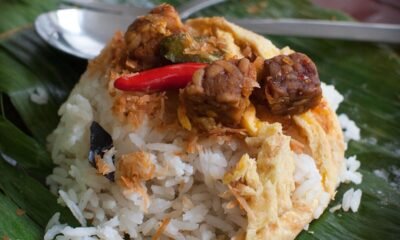Recipes
Make Delicious Millie’s Cookies Recipe at Home

Are you a fan of Millie’s Cookies and want to recreate their deliciousness in your own kitchen? You’re in luck! Here’s a step-by-step guide to making these iconic Millie’s Cookies Recipe at home.
Millie’s Cookies Recipe: The Basics
Millie’s Cookies are known for their soft, chewy texture and rich flavor. To get started, you’ll need the following ingredients:
- 125g unsalted butter, softened
- 100g light brown soft sugar
- 125g caster sugar
- 1 large egg
- 1 tsp vanilla extract
- 225g self-raising flour
- 200g chocolate chips
Instructions:
- Preheat the Oven: Set your oven to 180°C (160°C fan) and line two baking trays with parchment paper.
- Cream the Butter and Sugars: In a large mixing bowl, beat the softened butter with the light brown soft sugar and caster sugar until light and fluffy.
- Add Wet Ingredients: Beat in the egg and vanilla extract until well combined.
- Mix in Dry Ingredients: Gradually add the self-raising flour, mixing until a soft dough forms. Stir in the chocolate chips.
- Shape the Cookies: Roll the dough into walnut-sized balls and place them on the prepared baking trays. Flatten slightly with your fingers.
- Bake: Bake in the preheated oven for 7-10 minutes until the edges are golden but the center remains soft.
- Cool: Let the cookies cool on the baking tray for a few minutes before transferring them to a wire rack to cool completely.
Adding Your Own Twist
Double Chocolate Variation: Replace some or all of the chocolate chips with white chocolate chips, or use a mix of dark and white chocolate for a decadent treat.
Icing Topping: For an extra touch, drizzle your cooled cookies with a simple icing made from icing sugar mixed with a few drops of water or milk. You can also add vanilla extract or lemon juice for a flavor twist.
Expert Tips for Perfect Millie’s Cookies
- Use High-Quality Ingredients: This ensures the best flavor and texture.
- Soften the Butter Properly: Softened butter blends better with sugars, creating a light, fluffy texture.
- Avoid Overmixing: Overmixing the dough can lead to tough cookies. Mix just until combined.
- Chill the Dough: If the dough is too soft, chill it in the fridge for 30 minutes to prevent spreading during baking.
- Watch the Baking Time: For that perfect gooey center, keep an eye on your cookies and avoid overbaking.
Fun Variations and Customizations
M&M’s Cookies: Mix in M&M’s or similar candy-coated chocolates for a colorful and fun variation.
Salted Caramel: Drizzle baked cookies with caramel and a sprinkle of sea salt for a gourmet touch.
Espresso Chocolate Chip: Add a shot of espresso or some finely ground coffee to the dough for a sophisticated flavor.
A
Pairing and Serving Suggestions
With Beverages: Pair your Millie’s Cookies with a cold glass of milk, a hot cup of coffee, or a soothing cup of tea.
As Desserts: Make ice cream sandwiches by placing a scoop of ice cream between two cookies, or crumble the cookies over yogurt or oatmeal for a sweet topping.
For Special Occasions: Decorate with icing for themed parties, use heart-shaped cutters for Valentine’s Day, or package them as holiday gifts.
By following these steps and tips, you can enjoy the delightful taste of Millie’s Cookies anytime you want, right from your own kitchen. Happy baking!
Recipes
Cottage Cheese Recipes with Versatile Ingredient

Cottage cheese is a staple in many kitchens, loved for its mild, creamy texture and versatility. Cottage cheese is the perfect ingredient if you’re aiming to add more protein to your diet or looking for a light, nutrient-packed meal. It can be used in a variety of dishes, from savory snacks to indulgent desserts, making it an ideal choice for breakfast, lunch, or dinner. In this article, we’ll explore a range of cottage cheese recipes, from savory options like salads and dips to sweet dishes like parfaits and pancakes. Whether you’re cooking for yourself, your family, or hosting guests, there’s a recipe here to suit every taste and occasion.
Why Cottage Cheese?
Before diving into the recipes, let’s take a moment to understand why cottage cheese is such a fantastic ingredient. Known for its high protein content and low-fat profile, cottage cheese is an excellent choice for those looking to maintain a healthy lifestyle. It’s also rich in calcium, making it beneficial for bone health. Moreover, its mild flavor and creamy texture allow it to blend seamlessly into both savory and sweet dishes.
Whether you’re following a high-protein diet, looking for a light snack, or searching for a versatile ingredient to elevate your cooking, cottage cheese is a must-have in your pantry.
Savory Cottage Cheese Recipes
1۔ Cottage Cheese and Veggie Salad
A fresh and nutritious salad that can be made in minutes! Combine a generous scoop of cottage cheese with a mix of your favorite salad vegetables like cucumbers, tomatoes, spinach, and red onions. Add some nuts or seeds for crunch, and drizzle with olive oil and balsamic vinegar. This simple salad makes a refreshing and satisfying meal for lunch or dinner.
Ingredients:
- 1 cup cottage cheese
- 1 cucumber, diced
- 1 tomato, chopped
- A handful of spinach
- 1/4 red onion, thinly sliced
- 1 tbsp olive oil
- 1 tbsp balsamic vinegar
- Salt and pepper to taste
Instructions:
-
- Combine the cottage cheese, vegetables, and spinach in a large bowl.
- Drizzle with olive oil and balsamic vinegar.
- Toss gently and season with salt and pepper.
- Top with nuts or seeds for added texture.
- Serve immediately or refrigerate for a few hours for a chilled option.
2۔ Cottage Cheese and Avocado Toast
For a quick and healthy breakfast, top your whole-grain toast with a layer of cottage cheese, mashed avocado, and a sprinkle of chili flakes or lemon zest for extra flavor. It’s a simple yet satisfying dish that combines protein, healthy fats, and fiber.
Ingredients:
- 1 slice whole-grain bread
- 2 tbsp cottage cheese
- 1/2 avocado, mashed
- Salt and pepper to taste
- Red chili flakes or lemon zest (optional)
Instructions:
-
- Toast the bread until golden and crisp.
- Spread cottage cheese on top of the toast.
- Add a layer of mashed avocado.
- Sprinkle with chili flakes or lemon zest for an added kick.
- Season with salt and pepper, and enjoy!
3۔ Cottage Cheese Dip with Vegetables
This protein-packed dip is perfect for a healthy snack or appetizer. Simply blend cottage cheese with some Greek yogurt and your choice of seasonings (garlic, lemon, dill, and parsley work wonderfully). Serve it with fresh veggies or whole-grain crackers for a delightful bite.
Ingredients:
- 1 cup cottage cheese
- 1/2 cup Greek yogurt
- 1 tbsp lemon juice
- 1 garlic clove, minced
- 1 tbsp fresh dill
- Salt and pepper to taste
Instructions:
-
- Blend the cottage cheese and Greek yogurt in a food processor until smooth.
- Add lemon juice, minced garlic, dill, salt, and pepper, and blend again until everything is well combined.
- Serve with carrot sticks, cucumber slices, or whole-grain crackers.
4۔ Cottage Cheese and Chicken Wrap
For a high-protein lunch, fill a whole wheat wrap with grilled chicken, cottage cheese, and fresh vegetables like spinach, tomatoes, and cucumbers. Roll it up, and you have a quick, nutritious meal that’s both filling and delicious.
Ingredients:
- 1 whole wheat wrap
- 1/2 cup cottage cheese
- 1 grilled chicken breast, sliced
- Handful of spinach
- 1/4 tomato, sliced
- 1/4 cucumber, sliced
Instructions:
-
- Lay the wrap flat and spread cottage cheese in the center.
- Add the sliced grilled chicken and vegetables.
- Roll the wrap tightly, fold in the sides, and slice.
- Enjoy immediately or pack for lunch!
Recipes of Sweet Cottage Cheese
1۔ Cottage Cheese Parfait
A healthy alternative to sugary desserts, the cottage cheese parfait is packed with protein and can be customized with your favorite fruits and toppings. Layer cottage cheese with fresh berries, honey, and a sprinkle of granola for a satisfying snack or breakfast.
Ingredients:
- 1 cup cottage cheese
- 1/2 cup fresh mixed berries (blueberries, strawberries, raspberries)
- 1 tbsp honey
- 2 tbsp granola
Instructions:
-
- Layer cottage cheese in a serving glass or bowl.
- Top with fresh berries, drizzle with honey, and sprinkle with granola.
- Repeat the layers until the glass is full.
- Serve immediately for a fresh, protein-packed dessert or breakfast.
2۔ Cottage Cheese Pancakes
These pancakes are a delicious way to incorporate cottage cheese into your breakfast. The cottage cheese adds moisture and a creamy texture, making these pancakes extra fluffy and filling.
Ingredients:
- 1/2 cup cottage cheese
- 1/4 cup flour
- 1 egg
- 1/4 tsp baking powder
- 1 tsp vanilla extract
- 1 tbsp honey or maple syrup (optional)
Instructions:
-
- In a bowl, whisk together the cottage cheese, egg, flour, baking powder, and vanilla extract.
- Heat a non-stick skillet over medium heat and lightly grease it.
- Pour small amounts of batter onto the skillet, forming pancakes.
- Cook for 2-3 minutes on each side until golden brown.
- Serve with honey or maple syrup for an indulgent yet healthy breakfast.
3۔ Cottage Cheese and Fruit Smoothie
For a quick, nutrient-packed breakfast, blend cottage cheese with your favorite fruits, like bananas, strawberries, and mango. Add a splash of almond milk or juice for a creamy and refreshing smoothie that’s perfect for a busy morning.
Ingredients:
- 1/2 cup cottage cheese
- 1/2 banana
- 1/4 cup strawberries
- 1/4 cup mango
- 1/2 cup almond milk (or your preferred milk)
Instructions:
-
- Blend all ingredients in a high-speed blender until smooth.
- Pour into a glass and enjoy your creamy, protein-rich smoothie!
4۔ Cottage Cheese Stuffed Peaches
A lovely summer dessert or snack, cottage cheese stuffed peaches is both delicious and nutritious. The sweetness of the peaches pairs perfectly with the creaminess of the cottage cheese, making this dish a crowd-pleaser.
Ingredients:
- 2 peaches, halved and pitted
- 1/2 cup cottage cheese
- 1 tbsp honey
- 1/4 tsp cinnamon
Instructions:
-
- Slice the peaches in half and remove the pits.
- Fill each peach half with a scoop of cottage cheese.
- Drizzle with honey and sprinkle with cinnamon.
- Serve immediately or refrigerate for a chilled treat.
Conclusion
From savory dishes to sweet treats, cottage cheese proves to be a versatile ingredient that can be used in a variety of delicious and healthy recipes. Whether you’re looking for a filling breakfast, a refreshing lunch, or a satisfying dessert, there’s a cottage cheese recipe that fits the bill. Packed with protein and essential nutrients, cottage cheese can elevate your meals while keeping them light and nutritious.
Experiment with these recipes and make cottage cheese a regular part of your culinary repertoire—your taste buds and body will thank you!
Breakfast
Cottage Cheese Flatbread Delicious and Nutritious Twist

Flatbread is a staple in many cultures around the world, and for good reason. It’s versatile, easy to make, and serves as a perfect accompaniment to a wide variety of dishes. However, if you’re looking to add a twist to your regular flatbread, why not try incorporating Cottage Cheese Flatbread? This protein-packed dairy product can transform a simple flatbread into a nutritious, flavorful, and satisfying snack or meal.
In this article, we’ll dive into everything you need to know about cottage cheese flatbread, including its benefits, ingredients, and how to make it at home.
What is Cottage Cheese Flatbread?
Cottage cheese flatbread is a variation of traditional flatbread that uses cottage cheese as a key ingredient. Cottage cheese is a soft, mild cheese that is low in fat and high in protein. When incorporated into flatbread dough, it not only enhances the texture but also adds a subtle creaminess and depth of flavor. The result is a soft, fluffy, and slightly tangy flatbread that is both nutritious and satisfying.
Health Benefits of Cottage Cheese
Before we delve into the recipe and preparation process, let’s take a moment to appreciate the health benefits of cottage cheese, which make it an excellent addition to your diet:
- High in Protein: Cottage cheese is an excellent source of casein protein, a slow-digesting protein that helps support muscle growth and repair. It’s especially beneficial for athletes, bodybuilders, or anyone looking to increase their protein intake.
- Rich in Calcium: Cottage cheese is also rich in calcium, an essential mineral that supports bone health, nerve function, and muscle contraction.
- Low in Fat: Cottage cheese can be found in various fat levels, from full-fat to low-fat and fat-free options, allowing you to choose a version that fits your dietary preferences and goals.
- Low in Carbohydrates: For those on low-carb or ketogenic diets, cottage cheese is a great choice due to its minimal carbohydrate content, making it a suitable option for maintaining stable blood sugar levels.
- Probiotic Benefits: Some cottage cheese varieties contain probiotics, beneficial bacteria that support gut health and improve digestion.
Ingredients for Cottage Cheese Flatbread
While the basic ingredients for flatbread generally include flour, water, salt, and some form of leavening agent, the inclusion of cottage cheese adds an extra layer of richness and flavor. Here are the essential ingredients for making cottage cheese flatbread:
- Cottage cheese (1 cup): The star ingredient, providing creaminess and protein.
- All-purpose flour (1 to 1.5 cups): Used as the base for the dough. You can experiment with whole wheat or gluten-free flour for a healthier alternative.
- Baking powder (1 teaspoon): To help the dough rise slightly and create a fluffier texture.
- Olive oil (1 tablespoon): For moisture and added flavor.
- Salt (1/2 teaspoon): Enhances the flavor of the dough.
- Water (as needed): To bring the dough together. Start with a few tablespoons and adjust based on the consistency.
- Optional spices or herbs: For added flavor, you can include garlic powder, onion powder, cumin, or dried oregano, depending on your taste preferences.
How to Make Cottage Cheese Flatbread: A Step-by-Step Guide
Making cottage cheese flatbread is relatively simple and requires no special equipment. Here’s a step-by-step guide to help you create this delicious and nutritious dish at home:
Step 1: Prepare the Dough
- In a large bowl, combine the cottage cheese, olive oil, and salt. Mix well.
- Gradually add the flour, starting with 1 cup, and stir it into the mixture. Once it becomes too thick to stir, use your hands to knead the dough.
- Slowly add water a tablespoon at a time until the dough comes together. It should be soft and slightly sticky, but not overly wet.
- If you’re adding any spices or herbs, incorporate them into the dough at this stage.
Step 2: Rest the Dough
Cover the dough with a clean kitchen towel and let it rest for about 15–20 minutes. This allows the flour to fully absorb the moisture and helps the dough become more pliable.
Step 3: Roll Out the Dough
Once the dough has rested, divide it into small equal portions (around 4–6 depending on your preferred size). Roll each portion into a ball and then flatten it into a round or oval shape using a rolling pin. Aim for a thickness of about 1/4 inch.
Step 4: Cook the Flatbread
Heat a non-stick skillet or griddle over medium-high heat. Place one of the rolled-out dough pieces onto the skillet. Cook for about 2–3 minutes on each side, or until golden brown spots appear. You may notice some puffing as the flatbread cooks, which is a sign of the dough’s light and airy texture.
Step 5: Serve and Enjoy
Once all the flatbreads are cooked, serve them warm with your favorite dip, curry, or salad. Cottage cheese flatbread also pairs wonderfully with hummus, tzatziki, or a simple yogurt-based sauce. You can even enjoy them on their own as a snack.
Tips for Perfect Cottage Cheese Flatbread
- Adjust Consistency: If the dough feels too sticky, you can add a little more flour to make it easier to work with. If it’s too dry, add a touch more water.
- Flavor Variations: For added flavor, you can mix in fresh herbs like cilantro, parsley, or mint, or add spices like cumin, coriander, or smoked paprika to the dough.
- Texture: If you prefer a slightly crispy flatbread, roll the dough thinner. For a fluffier texture, keep it thicker when rolling out the dough.
- Storage: Cottage cheese flatbread can be stored in an airtight container for 1–2 days at room temperature, or up to a week in the refrigerator. You can also freeze them for longer storage.
Conclusion
Cottage cheese flatbread is a simple, delicious, and nutritious alternative to traditional flatbreads. It combines the soft texture and richness of cottage cheese with the versatility of flatbread, making it a perfect addition to any meal. Whether you’re looking for a healthy snack or a side dish to complement a curry or dip, cottage cheese flatbread is sure to become a favorite in your kitchen. Give it a try and enjoy the perfect blend of flavor and nutrition in every bite!
FOOD
Süberlig Turkish Cuisine, Rich in Flavor and History

Turkish cuisine is a rich and diverse blend of flavors, traditions, and cultural influences. Known for its use of fresh, local ingredients and unique culinary techniques, Turkish food offers a taste experience like no other. One dish that stands out in the spectrum of Turkish culinary heritage is Süberlig.
Though it may not be as widely known outside of Turkey, Süberlig is a beloved and traditional dish, deeply rooted in the country’s diverse gastronomic history. This dish combines an array of spices, vegetables, and meats, offering a unique representation of Turkish food culture. To understand Süberlig is to understand the very essence of Turkish cuisine—rich, hearty, and filled with history.
The Rich History of Turkish Cuisine and Süberlig
The origins of Turkish cuisine can be traced back to the ancient Anatolian civilizations, such as the Hittites, Greeks, and Romans, all of whom contributed to the evolving food culture. Turkish food is also heavily influenced by the Ottoman Empire, which spread its culinary traditions across vast territories, blending Eastern, Central Asian, Middle Eastern, and Mediterranean flavors. The result is a complex, multifaceted cuisine that is both diverse and unified by its focus on fresh, local ingredients and aromatic spices.
Süberlig is a dish that embodies the spirit of Turkish culinary history. It carries the flavors of the country’s many regions, combining rustic ingredients with refined cooking methods. As is typical of Turkish dishes, Süberlig is a reflection of the diverse climate and agricultural products that Turkey is known for, such as fresh herbs, olive oil, and high-quality meat.
While there may not be a single “official” origin story for Süberlig, it is widely recognized as a regional dish, especially popular in the Southeastern Anatolia region of Turkey. Like many traditional Turkish dishes, Süberlig is often prepared for family gatherings and festive occasions, making it a symbol of community and shared history.
What is Süberlig? A Taste of Tradition
Süberlig is a hearty and flavorful dish that typically features a combination of vegetables, meat (often lamb or beef), and a rich blend of spices. While the exact ingredients and preparation may vary by region and family traditions, Süberlig is generally a stew or casserole-style dish. What sets it apart from other Turkish dishes is the unique combination of flavors and the specific herbs and spices used to enhance the natural ingredients.
Key Ingredients in Süberlig
- Meat: Süberlig often uses lamb or beef, which are staples in Turkish cuisine. The meat is typically cooked until tender, allowing it to absorb the rich flavors of the spices and vegetables.
- Vegetables: The dish usually contains a mix of seasonal vegetables, such as tomatoes, onions, peppers, and eggplant. These ingredients form the base of the stew, adding both flavor and texture.
- Spices: A distinctive blend of spices is essential to the Süberlig flavor profile. Common spices include cumin, paprika, cinnamon, and sumac. These aromatic spices create a balance between earthy, sweet, and slightly tangy flavors.
- Herbs: Fresh herbs, such as parsley, mint, and dill, are frequently used to garnish the dish, adding a touch of freshness and complexity to the finished meal.
Cooking Method
Süberlig is typically slow-cooked, allowing the meat to become tender and the vegetables to absorb the spices. The dish can be prepared in a variety of ways, but it is often made in a large pot or casserole dish, where the ingredients are layered and cooked over low heat for several hours. The slow-cooking process ensures that the flavors meld together, creating a rich, aromatic stew that is perfect for sharing.
Süberlig’s Cultural Significance in Turkey
Like many traditional Turkish dishes, Süberlig carries cultural importance far beyond its delicious taste. It is a dish that brings people together, often prepared for family meals, celebrations, and communal gatherings. In Turkey, food is not just about sustenance; it is about creating connections and preserving traditions.
Süberlig is often seen as a comfort food, a reminder of home, and an essential part of Turkish hospitality. When hosting guests, Turkish families will often prepare dishes like Süberlig to showcase the richness of their culinary culture and to share a piece of their heritage. It embodies the spirit of generosity and togetherness that is central to Turkish dining customs.
This dish is also representative of the broader Turkish philosophy of eating—where food is meant to be shared and enjoyed in good company. Much like the famous Turkish meze or the renowned Kebabs, Süberlig is a communal dish, often served alongside rice or flatbread, encouraging everyone at the table to dig in and enjoy the flavors together.
Süberlig: A Reflection of Regional Turkish Cuisine
Turkey’s diverse geography means that each region has its own unique food culture, influenced by local produce, climate, and historical interactions with other cultures. Süberlig, although a dish that can be found in various parts of Turkey, is particularly popular in the southeastern regions, where the use of lamb, spices, and hearty vegetables is common.
In the Southeast, where the influence of Arabic and Persian cuisines is prominent, dishes like Süberlig are often made with robust, fragrant spices, like cumin and cinnamon, as well as more complex flavor combinations. The region’s cuisine often features slow-cooked stews and dishes that highlight the use of fresh, seasonal ingredients, making Süberlig a natural fit for this part of the country.
Moreover, Süberlig is often served with traditional accompaniments like pilav (rice pilaf), pide (Turkish flatbread), or yogurt on the side. These additions not only complement the flavors of the stew but also play an important role in balancing the rich spices and enhancing the overall dining experience.
How to Prepare Süberlig: A Simple Recipe
While the precise recipe for Süberlig can vary, here’s a basic approach to preparing this traditional Turkish dish at home:
Ingredients:
- 500g lamb or beef, cut into chunks
- 2 medium-sized onions, finely chopped
- 2 tomatoes, chopped
- 2 bell peppers, chopped
- 1 eggplant, chopped
- 2 tablespoons olive oil
- 1 teaspoon ground cumin
- 1 teaspoon paprika
- 1 teaspoon cinnamon
- Salt and pepper, to taste
- 1 cup of water or broth
- Fresh parsley, chopped (for garnish)
Instructions:
- Prepare the meat: Heat the olive oil in a large pot over medium heat. Add the lamb or beef chunks and sear them until browned on all sides. This step helps develop the base flavor of the dish.
- Add the vegetables: Once the meat is browned, add the chopped onions, tomatoes, peppers, and eggplant to the pot. Stir and cook for a few minutes until the vegetables start to soften.
- Season the dish: Sprinkle in the cumin, paprika, cinnamon, salt, and pepper. Stir well to ensure the meat and vegetables are coated with the spices.
- Cook the stew: Add the water or broth to the pot, bringing it to a boil. Once it boils, reduce the heat to low and cover the pot. Let the dish simmer for 1.5 to 2 hours, or until the meat is tender and the flavors have melded together.
- Garnish and serve: Once cooked, sprinkle fresh parsley on top for added freshness and color. Serve the Süberlig with rice, flatbread, or a dollop of yogurt on the side.
Süberlig in the Modern Day: A Dish for All Seasons
Though Süberlig is deeply rooted in tradition, it is a dish that remains relevant today. As Turkish cuisine continues to influence food culture globally, dishes like Süberlig are being rediscovered by a new generation of food lovers. Whether enjoyed in Turkey or abroad, Süberlig offers a timeless taste of Turkish hospitality, history, and flavor.
Frequently Asked Questions
What is Süberlig?
Süberlig is a traditional Turkish dish made with meat, vegetables, and a blend of aromatic spices, often slow-cooked to develop rich, complex flavors.
Where is Süberlig most popular in Turkey?
Süberlig is particularly popular in Southeastern Turkey, where the use of lamb, fresh vegetables, and spices is prevalent.
What are the key ingredients in Süberlig?
Key ingredients in Süberlig include lamb or beef, tomatoes, onions, bell peppers, eggplant, and spices such as cumin, paprika, and cinnamon.
How is Süberlig served?
Süberlig is typically served with rice, flatbread, or yogurt, and garnished with fresh parsley for added flavor and color.
-

 Technology2 weeks ago
Technology2 weeks agointernet chicks: A Digital Phenomenon
-

 Recipes9 months ago
Recipes9 months agoCrab Brulee Recipe: A Gourmet Delight
-

 Recipes9 months ago
Recipes9 months agoSmoothie CCL: A Delicious and Nutritious Trend
-

 FOOD2 weeks ago
FOOD2 weeks agoÇeciir: A Journey Through Turkish Cuisine
-

 FOOD9 months ago
FOOD9 months agoCornflake Meringue Cookies
-

 FOOD9 months ago
FOOD9 months agoNasi Uduk
-

 Recipes9 months ago
Recipes9 months agoThe Ultimate Bug Juice Camp Drink Recipe for Fun and Flavor
-

 BLOGS9 months ago
BLOGS9 months agoUnveiling the Innovation: BoltBól – Revolutionizing Accessibility and Mobility
